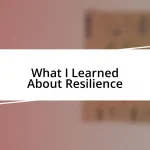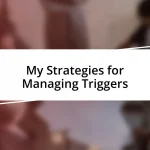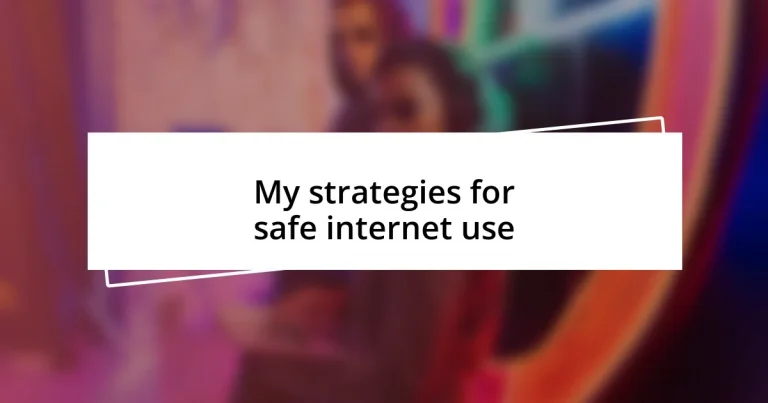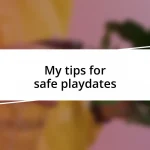Key takeaways:
- Use unique, complex passwords and consider password managers for better password management.
- Be cautious of sharing personal information online and recognize common online threats such as phishing and malware.
- Implement multi-factor authentication (MFA) to add an extra layer of security to accounts.
- Regularly update software and devices to protect against vulnerabilities and improve performance.
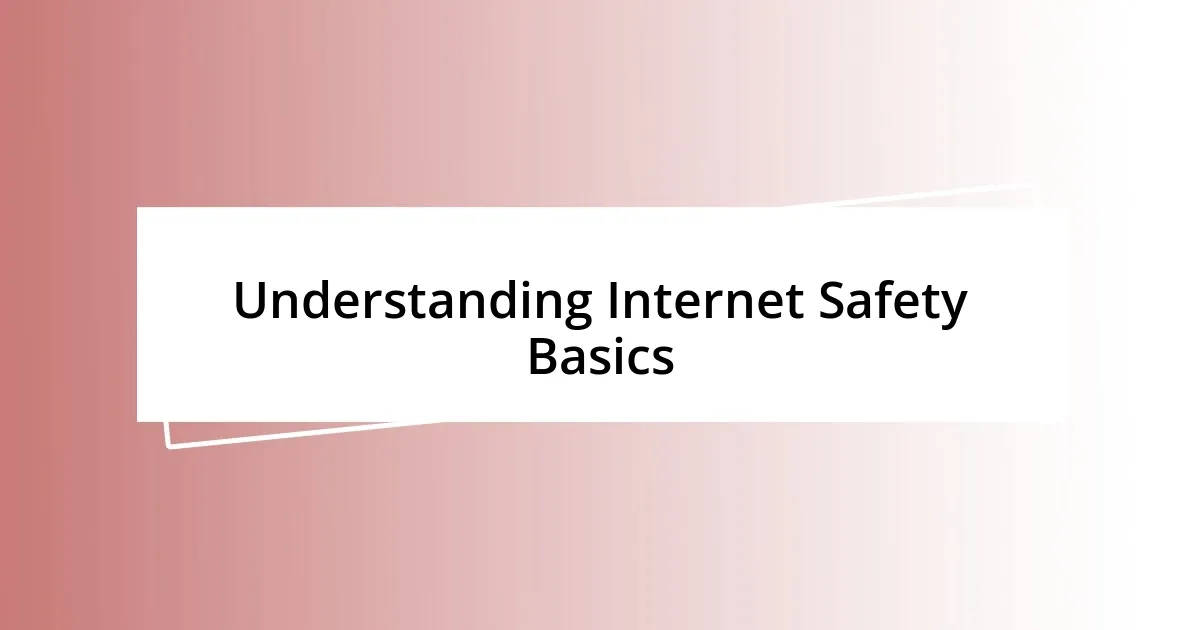
Understanding Internet Safety Basics
When I first ventured into the online world, I remember feeling a mix of excitement and apprehension. It’s crucial to understand that the internet isn’t always a safe space. A moment of vulnerability can lead to unwanted exposure or, worse, identity theft. Isn’t it interesting how a simple click can change everything?
Password management is another key aspect of internet safety. I learned the hard way that using the same password across multiple sites is like leaving the front door unlocked. Creating unique, complex passwords and utilizing password managers can drastically reduce risks. Have you ever felt the anxiety of forgetting a password? I certainly have, but the peace of mind that comes from knowing I’m more secure is worth the slight inconvenience.
Additionally, being cautious about sharing personal information online is essential. I once posted a seemingly harmless update about my travel plans, only to realize later that I had made it easier for anyone to know I wouldn’t be home. This experience taught me the importance of thinking before posting. How often do we forget that our digital footprint can follow us long after we hit “send”? Being mindful of what we share can make a significant difference in how we protect ourselves online.

Recognizing Online Threats
Recognizing online threats requires a keen sense of awareness, as countless dangers lurk beneath the surface of our daily Internet use. I still recall the day I clicked on what appeared to be a harmless link from a friend, only to find my device infected with malware. It was a shocking reminder of how easily even trusted contacts could lead us into dangerous situations. Knowing what to look out for can truly make a difference.
Here are some common online threats to recognize:
– Phishing Emails: These often look legitimate but try to trick you into providing personal information.
– Malware and Ransomware: Malicious software that can steal your data or hold it hostage until you pay a fee.
– Suspicious Links: Shortened URLs can conceal harmful sites; hovering over them can help reveal their true destination.
– Unsecured Wi-Fi Networks: Connecting to public Wi-Fi without proper security can expose your data to hackers.
– Social Engineering: Manipulating you into giving away information, typically through emotional appeals or urgent requests.
It’s essential to be cautious and question everything we encounter online. I’ve learned to trust my instincts; if something feels off, I don’t hesitate to dig deeper or consult a trusted source. Always trusting your gut will help you navigate through a sea of potential threats.
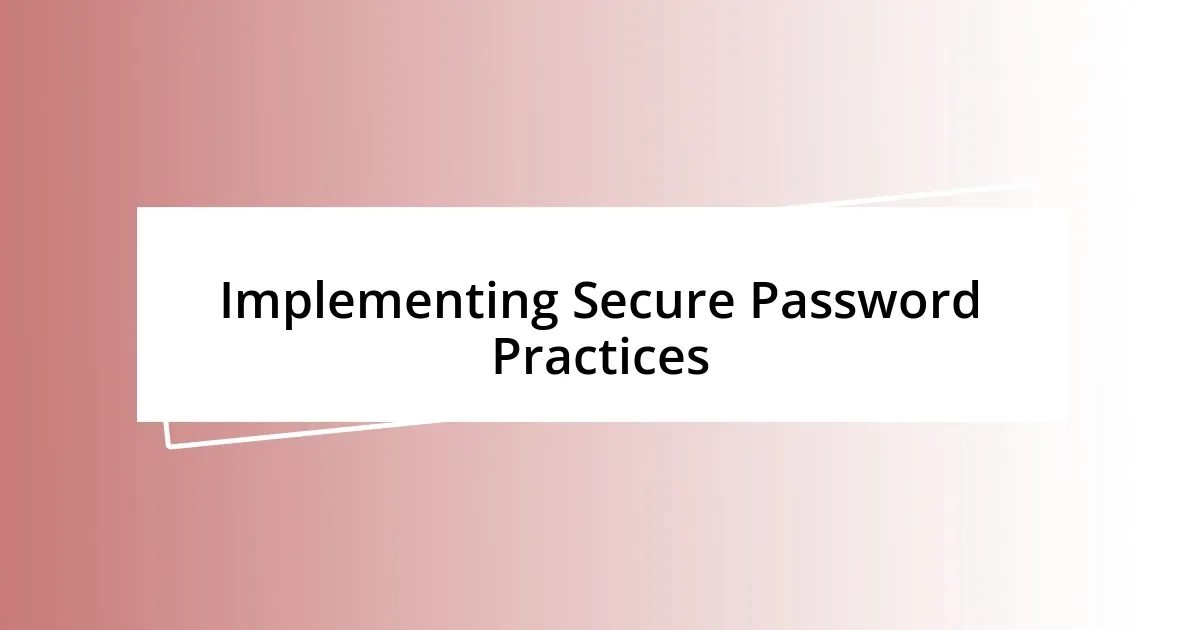
Implementing Secure Password Practices
Implementing secure password practices is vital in our digital lives. When I started taking my online security seriously, I felt overwhelmed by the plethora of advice out there. One simple tip that resonated with me was the idea of a “passphrase” instead of a password; something easy to remember yet unique. I created a quirky sentence based on a childhood memory, and to my delight, it was both secure and memorable. Have you ever tried using phrases instead of typical passwords? It can be a game-changer!
Another fantastic approach is to utilize a password manager. I was initially skeptical about entrusting my passwords to an app, but it simplified my life immensely. No longer did I have to reset forgotten passwords every few weeks, which made logging in much quicker and painless. And considering how many accounts we juggle today, aren’t you also tired of the constant cycle of forgotten passwords? They can feel like a digital maze!
To further enhance your password practices, multi-factor authentication (MFA) is an essential step. I remember setting it up on my email for the first time, and honestly, I was amazed at how it added an extra layer of security. With MFA, even if someone got hold of my password, they wouldn’t access my account without the second factor, often something I had on me at all times. I felt a surge of confidence knowing I had made my online presence much safer.
| Practice | Description |
|---|---|
| Unique Passwords | Create a unique password for each account to avoid cross-site vulnerabilities. |
| Passphrases | Use memorable sentences or phrases that are longer for increased security. |
| Password Managers | Utilize software to securely store and generate complex passwords. |
| Multi-Factor Authentication | Enable additional verification methods to enhance account security. |
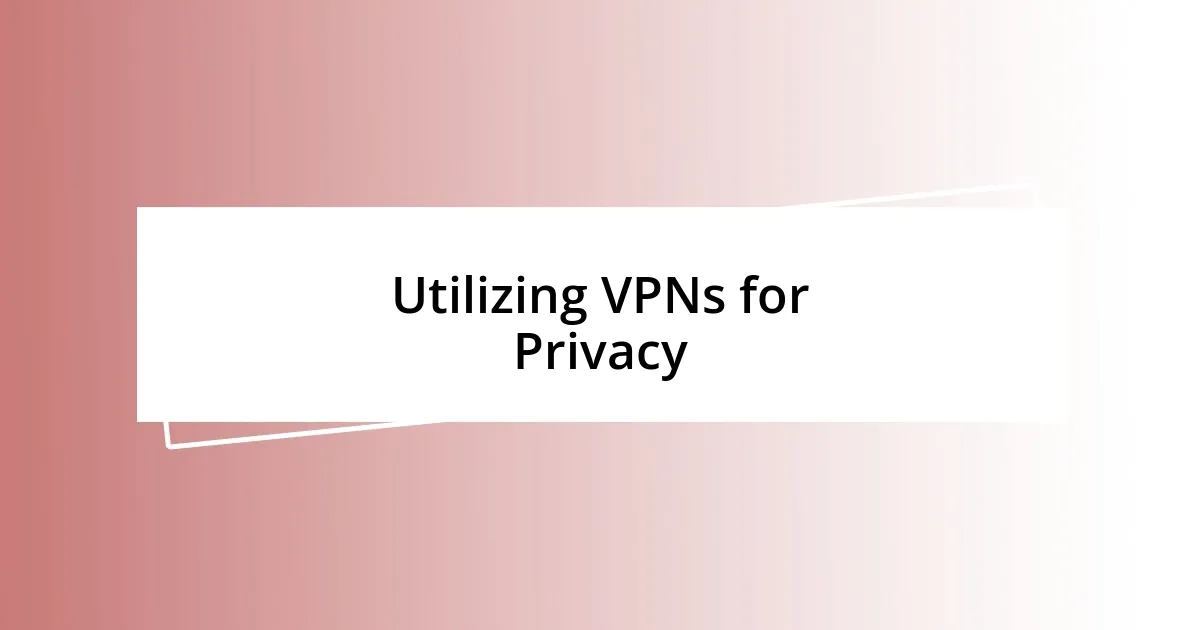
Utilizing VPNs for Privacy
Utilizing a VPN for privacy has become a vital step in my online security journey. I distinctly remember the first time I used one while connecting to public Wi-Fi. The moment I realized that my data was being encrypted, I felt an unexpected wave of relief wash over me. It’s like wrapping your most treasured belongings in a protective layer that keeps prying eyes at bay.
One of the biggest concerns I had was how much my online activities could be tracked by advertisers or even worse, malicious entities. When I learned that a VPN can mask my IP address, I felt empowered. Have you considered how often your digital footprints are monitored? Using a VPN made me feel like I was reclaiming my privacy, navigating the web without leaving behind a trail. Every time I browse in a secure manner, it’s a reminder to myself that I have taken control.
Not all VPNs are created equal, which I discovered during my search for the right one. I recall spending hours reading reviews and even trying out free trials before settling on a reliable service. It’s important to choose a VPN that doesn’t keep logs of your activity, ensuring that even they cannot divulge your information. What good is privacy if it’s not a true safeguard? By taking this extra step, I realized I was investing in my peace of mind, which is priceless in today’s digital age.
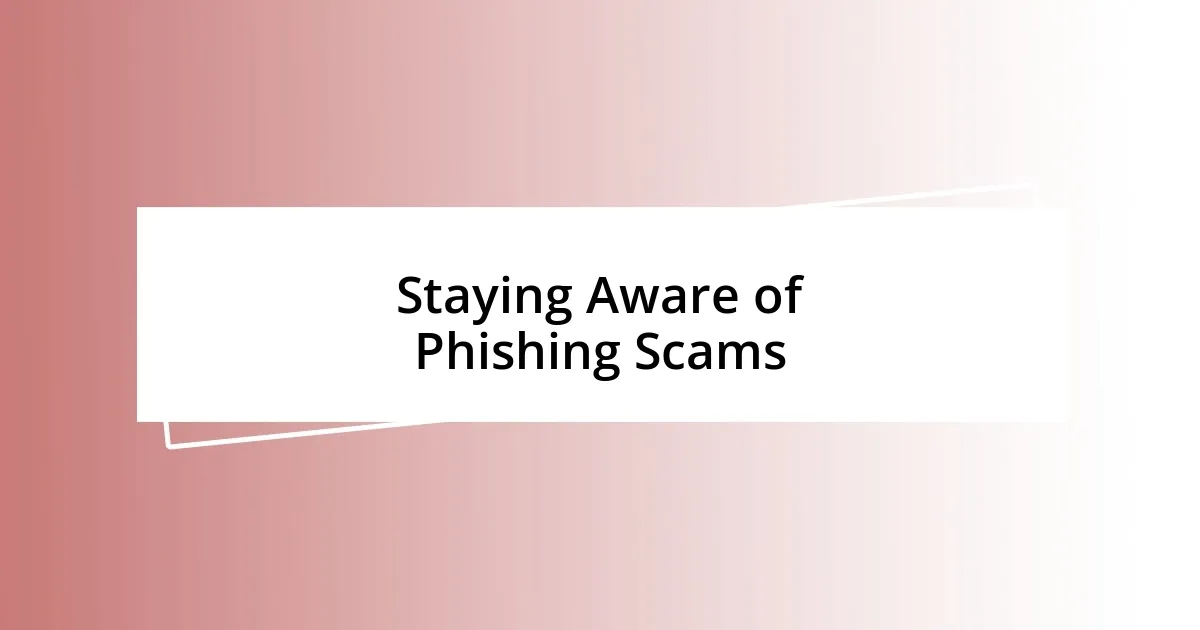
Staying Aware of Phishing Scams
Staying aware of phishing scams is crucial in safeguarding our online experiences. I still remember the sinking feeling I had when I clicked on what I thought was a legitimate link, only to discover it was a well-crafted phishing attempt. It sparked a realization that awareness isn’t just about spotting the signs; it’s also about being cautious with every click. Have you ever taken a moment to scrutinize a link before clicking? You might be surprised at what you find.
One key tactic is to double-check the email sender’s address. I’ve found that even small differences, like a missing letter or an extra number, can be a major red flag. When I noticed a suspicious email from a company I frequently deal with, the slight variation in the domain caught my eye. It prompted me to verify! Wouldn’t it make sense to investigate rather than assume? I encourage you to develop that habit because a second look can save you a world of trouble.
Another effective strategy is to stay informed about common phishing methods. There’s a sense of empowerment that comes when I recognize the typical tricks. For instance, the urgency often pushed in these messages can be a trap; I’ve learned to take a step back when I feel rushed to act. Have you felt that pressure before? Knowing that it’s a common tactic has made me more resilient against these scams. Just by sharing tips with friends about what to watch for, I’ve created a safer online community for myself and others.
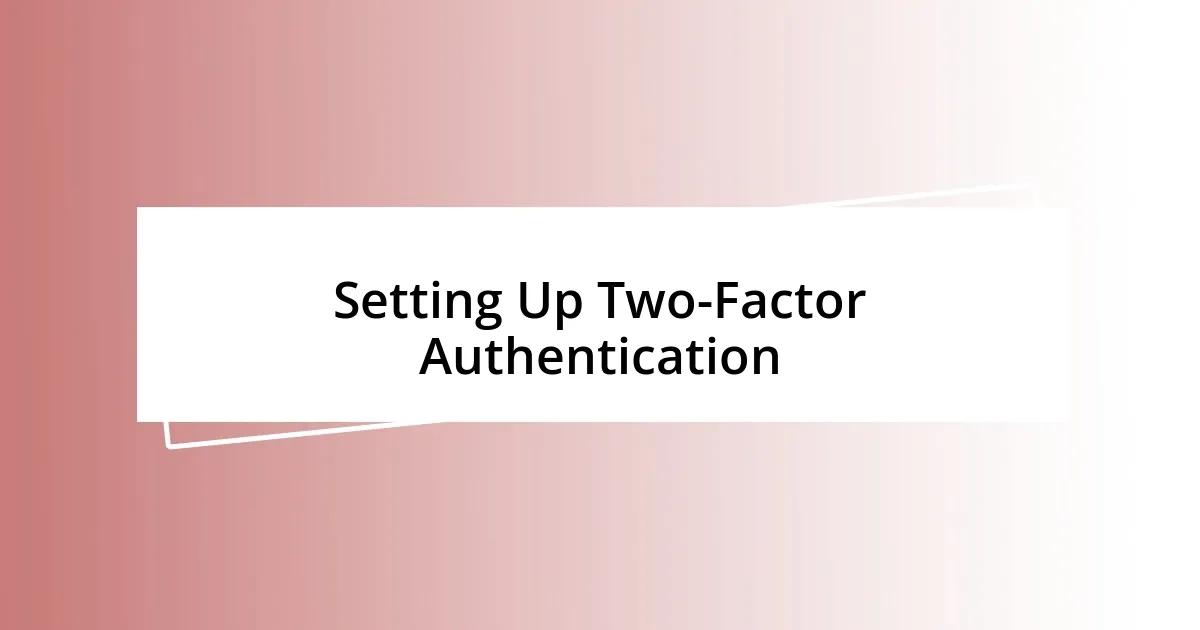
Setting Up Two-Factor Authentication
Setting up two-factor authentication (2FA) has felt like one of the most empowering steps I’ve taken for my online security. When I first added 2FA to my accounts, it was a revelation. Knowing that a simple code generated on my phone would serve as another layer of protection brought me immense peace of mind. Have you ever wondered how much safer you could feel with this added measure? It’s like having a secret key that only you possess – it guards your digital identity against unwanted access.
During the process, I remember facing a bit of a learning curve. Initially, I worried about forgetting my 2FA code or having issues if I lost my phone. To ease my anxiety, I made it a habit to keep backup codes in a secure place. This simple adjustment transformed my apprehension into confidence. I realized that having those codes saved could truly save the day, preventing that dreaded lockout moment. Have you thought about where you might store your backup codes for the best security? The right approach can take your online safety to the next level.
Once I had 2FA set up, I noticed how much more vigilant I became about my online activity. The sense of accountability it instilled in me made me rethink my password choices; they had to be strong enough to withstand attacks. I also found myself regularly updating passwords and engaging with security alerts more seriously. It felt like taking charge of my digital life, and I genuinely recommend making 2FA a non-negotiable part of your internet use. What impact would it have on your online behavior if you knew you had an extra layer of protection in place?

Regularly Updating Software and Devices
Regularly updating software and devices is one of those simple yet powerful moves that can significantly enhance online safety. I’ll never forget the moment I updated my operating system one evening, only to discover new features alongside crucial security patches. It felt fantastic to know I was actively fortifying my defenses against potential threats. Have you ever felt a sense of accomplishment after hitting that “update” button?
The realization hit me one day when I read that outdated software could leave backdoors open for cybercriminals. That’s when I began to set reminders to update not just my computer, but my smartphone and apps as well. I can relate to the frustration of constant pop-ups asking for updates, but I’ve come to view these reminders as a friendly nudge towards better security. How often do we overlook that simple step, thinking, “I’ll do it later”? Taking just a few minutes can save us from a lot of headaches down the line.
Having the latest updates not only secures my devices but also improves their performance. I recall experiencing a noticeable lag in my favorite app until I updated it, and the difference was astounding. While it can sometimes feel like a chore, viewing these updates as essential care for my digital life makes it much easier to prioritize them. Would you consider it as vital as getting regular check-ups for your health? After all, keeping everything updated ensures I’m protected and experiencing the best possible performance from my tech.
